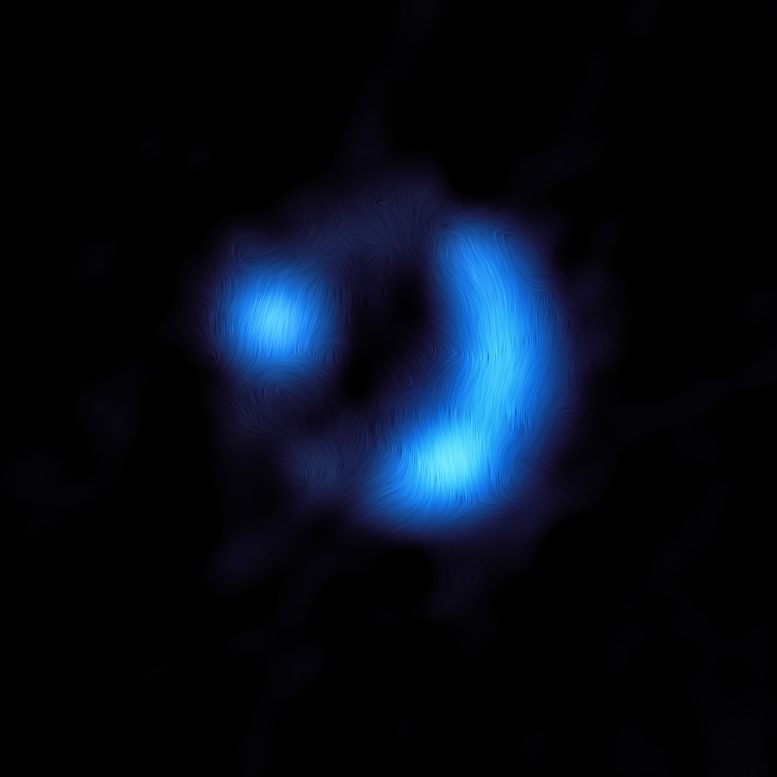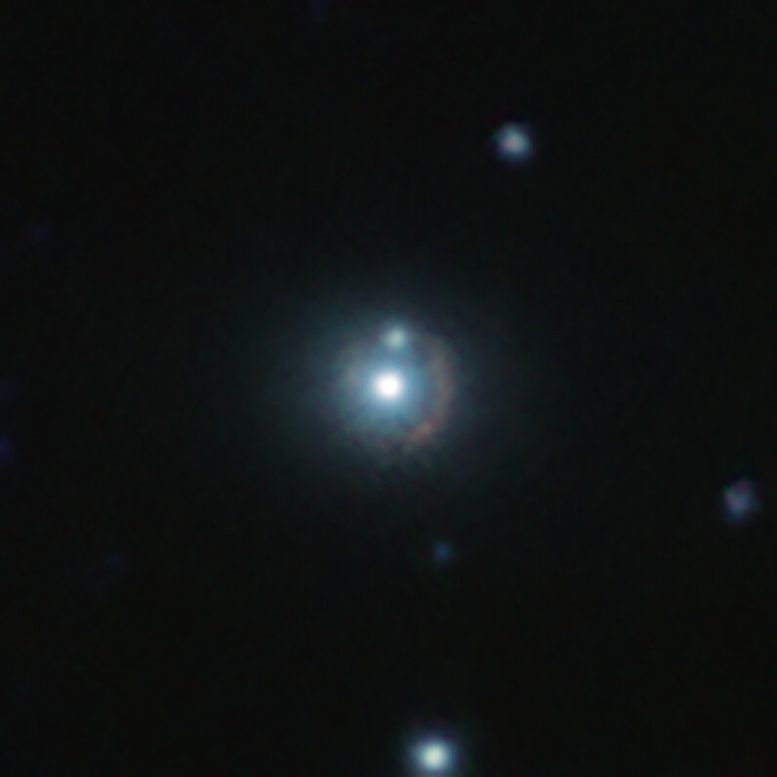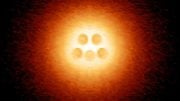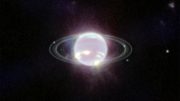
This image shows the orientation of the magnetic field in the distant 9io9 galaxy, seen here when the Universe was only 20% of its current age — the furthest ever detection of a galaxy’s magnetic field. Dust grains within 9io9 are somewhat aligned with the galaxy’s magnetic field, and due to this, they emit polarized light, meaning that light waves oscillate along a preferred direction rather than randomly. ALMA detected this polarization signal, from which astronomers could work out the orientation of the magnetic field, shown here as curved lines overlaid on the ALMA image. Credit: ALMA (ESO/NAOJ/NRAO)/J. Geach et al.
Astronomers have discovered an ancient galaxy’s magnetic field, shedding light on the early universe’s cosmic evolution and star formation processes.
Using the Atacama Large Millimeter/submillimeter Array (ALMA), astronomers have detected the magnetic field of a galaxy so far away that its light has taken more than 11 billion years to reach us: we see it as it was when the Universe was just 2.5 billion years old. The result provides astronomers with vital clues about how the magnetic fields of galaxies like our own Milky Way came to be.
Using ALMA, astronomers have detected the magnetic field of a galaxy so far away that its light has taken more than 11 billion years to reach us. Never before had we detected a galaxy’s magnetic field this far away. This video summarizes the discovery. Credit: ESO
Magnetic Fields Across the Universe
Lots of astronomical bodies in the Universe have magnetic fields, whether it be planets, stars, or galaxies. “Many people might not be aware that our entire galaxy and other galaxies are laced with magnetic fields, spanning tens of thousands of light-years,” says James Geach, a professor of astrophysics at the University of Hertfordshire, UK, and lead author of the study published recently in the scientific journal Nature.
“We actually know very little about how these fields form, despite their being quite fundamental to how galaxies evolve,” adds Enrique Lopez Rodriguez, a researcher at Stanford University, USA, who also participated in the study. It is not clear how early in the lifetime of the Universe, and how quickly, magnetic fields in galaxies form because so far astronomers have only mapped magnetic fields in galaxies close to us.

This infrared image shows the distant galaxy 9io9, seen here as a reddish arc curved around a bright nearby galaxy. This nearby galaxy acts as a gravitational lens: its mass curves spacetime around it, bending lightrays coming from 9io9 in the background, hence its distorted shape. This color view results from combining infrared images taken with ESO’s Visible and Infrared Survey Telescope for Astronomy (VISTA) in Chile and the Canada France Hawaii Telescope (CFHT) in the US. Credit: ESO/J. Geach et al.
The Role of Star Formation and Future Research
Now, using ALMA, in which the European Southern Observatory (ESO) is a partner, Geach and his team have discovered a fully formed magnetic field in a distant galaxy, similar in structure to what is observed in nearby galaxies. The field is about 1000 times weaker than the Earth’s magnetic field, but extends over more than 16,000 light-years.
“This discovery gives us new clues as to how galactic-scale magnetic fields are formed,” explains Geach. Observing a fully developed magnetic field this early in the history of the Universe indicates that magnetic fields spanning entire galaxies can form rapidly while young galaxies are still growing.
The team believes that intense star formation in the early Universe could have played a role in accelerating the development of the fields. Moreover, these fields can in turn influence how later generations of stars will form. Co-author and ESO astronomer Rob Ivison says that the discovery opens up “a new window onto the inner workings of galaxies, because the magnetic fields are linked to the material that is forming new stars.”
This video takes us on a journey from our home in the Milky Way to a galaxy far, far away, 9io9. We first see the night sky in visible light, and then switch to infrared light when we finally reach 9io9. Here, the galaxy appears as a faint reddish arc curved around a bright nearby galaxy. We then see the ALMA image of 9io9 at millimeter wavelengths, with the orientation of the magnetic field indicated by overlaid curves. Credit: ESO/ALMA (ESO/NAOJ/NRAO)/DESI/CFHT/N. Risinger (skysurvey.org)/J. Geach et al.
Techniques for Detecting Distant Magnetic Fields
To make this detection, the team searched for light emitted by dust grains in a distant galaxy, 9io9.[1] Galaxies are packed full of dust grains and when a magnetic field is present, the grains tend to align and the light they emit becomes polarized. This means that the light waves oscillate along a preferred direction rather than randomly. When ALMA detected and mapped a polarized signal coming from 9io9, the presence of a magnetic field in a very distant galaxy was confirmed for the first time.
“No other telescope could have achieved this,” says Geach. The hope is that with this and future observations of distant magnetic fields the mystery of how these fundamental galactic features form will begin to unravel.
Reference: “Polarized thermal emission from dust in a galaxy at redshift 2.6” by J. E. Geach, E. Lopez-Rodriguez, M. J. Doherty, Jianhang Chen, R. J. Ivison, G. J. Bendo, S. Dye and K. E. K. Coppin, 6 September 2023, Nature.
DOI: 10.1038/s41586-023-06346-4
Notes
- 9io9 was discovered in the course of a citizen science project. The discovery was helped by viewers of the British BBC television program Stargazing Live, when over three nights in 2014 the audience was asked to examine millions of images in the hunt for distant galaxies.
The research team is composed of J. E. Geach (Centre for Astrophysics Research, School of Physics, Engineering and Computer Science, University of Hertfordshire, UK [Hertfordshire]), E. Lopez-Rodriguez (Kavli Institute for Particle Astrophysics and Cosmology, Stanford University, USA), M. J. Doherty (Hertfordshire), Jianhang Chen (European Southern Observatory, Garching, Germany [ESO]), R. J. Ivison (ESO), G. J. Bendo (UK ALMA Regional Centre Node, Jodrell Bank Centre for Astrophysics, Department of Physics and Astronomy, The University of Manchester, UK), S. Dye (School of Physics and Astronomy, University of Nottingham, UK) and K. E. K. Coppin (Hertfordshire).









Polarized magnetic field has just been observed and calculated from supermassive black hole M 87*.This phenomena is explained by Thermal(thermodynamic)- Quantum Mecanc(s/al) Relationship.Likely,magnetic field of galaxy 9i⁰9 can be explained and mass is calculated;this fact can also be studied by GR.